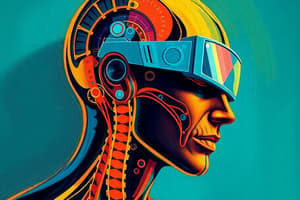Podcast
Questions and Answers
What is proprioception?
What is proprioception?
Proprioception is the ability to perceive the position and movement of our body parts, to localize ourselves in space, and to sense force, heaviness and the tension of our muscles from an internal perspective.
What are the three types of receptors that are primarily responsible for proprioception?
What are the three types of receptors that are primarily responsible for proprioception?
The three types of receptors primarily responsible for proprioception are muscle spindle receptors, Golgi tendon organs, and joint receptors.
Give an example of how proprioception is tested by doctors.
Give an example of how proprioception is tested by doctors.
Doctors often test proprioception by asking patients to close their eyes and touch their nose with their index finger.
Which of these situations demonstrates the importance of proprioception?
Which of these situations demonstrates the importance of proprioception?
Proprioception is only used for elementary automatic responses, like the knee jerk reflex.
Proprioception is only used for elementary automatic responses, like the knee jerk reflex.
What is a common way to assess balancing ability?
What is a common way to assess balancing ability?
What is the rubber hand illusion (RHI) and what does it demonstrate?
What is the rubber hand illusion (RHI) and what does it demonstrate?
Proprioceptive accuracy deteriorates with age and in several movement disorders.
Proprioceptive accuracy deteriorates with age and in several movement disorders.
How can proprioceptive accuracy be improved?
How can proprioceptive accuracy be improved?
Explain how proprioception can influence emotional experience.
Explain how proprioception can influence emotional experience.
Flashcards
Proprioception
Proprioception
The ability to sense the position and movement of body parts without using vision.
Proprioceptors
Proprioceptors
Specialized receptors that detect the position and movement of body parts.
Muscle Spindles
Muscle Spindles
Proprioceptors sensitive to muscle stretching.
Golgi Tendon Organs
Golgi Tendon Organs
Signup and view all the flashcards
Joint Receptors
Joint Receptors
Signup and view all the flashcards
Efferent Copy
Efferent Copy
Signup and view all the flashcards
Body Ownership
Body Ownership
Signup and view all the flashcards
Rubber Hand Illusion (RHI)
Rubber Hand Illusion (RHI)
Signup and view all the flashcards
Proprioceptive Accuracy
Proprioceptive Accuracy
Signup and view all the flashcards
Joint Position Reproduction Test
Joint Position Reproduction Test
Signup and view all the flashcards
Balance
Balance
Signup and view all the flashcards
Balance Assessment
Balance Assessment
Signup and view all the flashcards
Power Posing
Power Posing
Signup and view all the flashcards
Motor Performance
Motor Performance
Signup and view all the flashcards
Proprioceptive Training
Proprioceptive Training
Signup and view all the flashcards
Knee Jerk Reflex
Knee Jerk Reflex
Signup and view all the flashcards
Study Notes
Proprioception
- Proprioception is the ability to perceive the position and movement of body parts, without visual input.
- It includes sensing force, heaviness, and muscle tension.
- Proprioception is used for tasks like touching one's nose with their fingers, even with eyes closed.
Proprioceptors
- Mechanoreceptors are the basis of proprioception, located in the locomotor system.
- Muscle spindle receptors sense stretching.
- Golgi tendon organs sense tendon tension.
- Joint receptors sense joint position.
- Skin mechanoreceptors contribute to proprioception.
- Efferent copy (sense of effort) helps predict motor command consequences.
Importance of Proprioception
- Crucial for smooth, controlled movements.
- Without accurate proprioception, people may not be able to control movements even if visual information is present.
- They may lose awareness of their body's position.
- Loss of body ownership can occur.
Proprioception and Movement Control
- Proprioceptive information is used at all levels of movement control.
- From basic automatic responses (like the knee-jerk reflex) to more complex, conscious actions (like balancing).
- Proprioception is integrated with other sensory modalities (like vision, touch).
- Balance is often assessed with visual input, however, its assessment can also include vestibular, tactile, and proprioceptive input.
- Balancing is important for performance in sports, and the prevention of injuries, especially for elderly people.
Assessing Proprioception
- Formal tests, such as joint position reproduction, are employed.
- Testing can involve measuring posture stability, and how well someone can maintain balance.
- Visual cues are often involved in balance tests, but balance tests also exist without visual cues.
Rubber Hand Illusion (RHI)
- The RHI demonstrates sensory integration.
- Visual and tactile input can override proprioceptive information.
- Experimenter covers one hand, places a rubber hand in front of participant.
- Touching the rubber hand synchronously with the unseen real hand causes participants to perceive the rubber hand as part of their body.
Proprioceptive Accuracy
- Proprioception accuracy varies among individuals.
- Performance declines with age.
- Proprioception accuracy is linked to motor skill performance and can be useful in diagnosing conditions like Parkinson's disease, and cerebral palsy..
- Proprioceptive training can be used to improve accuracy and regulation of movement.
Studying That Suits You
Use AI to generate personalized quizzes and flashcards to suit your learning preferences.



